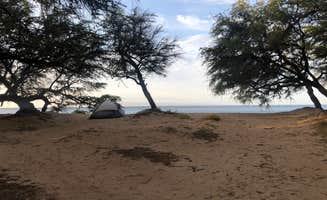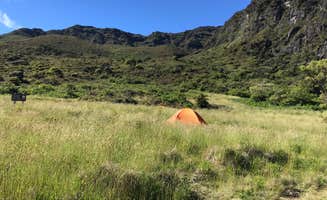Tent camping in Kihei, Hawaii offers access to diverse terrain ranging from sea level beaches to the summit of Haleakalā at 10,023 feet. Many campsites around Kihei experience significant temperature variations with coastal areas remaining warm while higher elevations can drop below 40°F after sunset. Backcountry tent camping requires proper preparation as sites are located in remote volcanic landscapes with limited facilities and often demanding hiking approaches.
What to do
Hike to volcanic landscapes: Holua Primitive Wilderness Campsite offers remarkable hiking opportunities through Haleakalā's crater. The campsite is accessible via a 3.8-mile trail at minimum, creating a true backcountry experience. As camper Amber A. notes, "Camping on lava flows is like nothing else. Gets chilly all times of the year due to the elevation."
Explore native forests: Venture into the cloud forests at Polipoli Spring State Recreation Area for hiking trails that pass abandoned ranger stations and unusual cave formations. "Polipoli does not even feel like you're in Hawaii! It's high upcountry tucked in the clouds and forests. The hike from the recreational area leads you to two abandoned ranger stations which are super cool," shares Savannah G.
Beach camping: Set up your tent directly on the shore at Papalaua Wayside Park for immediate beach access. The park offers basic amenities including portable toilets and trash collection. Visitors can easily access swimming areas and coastal hiking trails within walking distance of campsites.
What campers like
Isolation from crowds: Tent campers appreciate the solitude found at backcountry sites. At Paliku Backcountry Campsite, visitors enjoy a rare experience after a challenging hike. "This rainy side of the crater features rich, thick, and best of all - almost completely native Hawaiian plants and animals. I can't say that I've ever heard more interesting and diverse bird calls in my life," reports Bryce K.
Unique natural environments: Holua campers value the otherworldly landscape. "Unreal! It's like your on the moon. O! Watch for a NeNe, this bird is very rare and lives on at the top of this mountain," writes Shae M., highlighting the opportunity to observe endangered species.
Affordable coastal camping: Papalaua Wayside Park offers budget-conscious options near premium tourist areas. "The cheapest place to camp on the west side of Maui. Located on the southern shore, the camping is all beach camping right along the beautiful coast. Trees for shade, porta potties for bathrooms," explains Carrie S.
What you should know
Permit requirements: Most Kihei area camping requires advance planning. Whitney M. explains that for Holua, "Camping permits can be obtained at the Headquarters Visitor Center between 8:00am and 3:00pm up to one day in advance. Permits are free and require photo identification and a 10-minute orientation."
Weather preparation: Pack for extreme temperature variations regardless of season. Jordan T. shares about Holua, "The guys we talked to said it was constantly raining the night before, so they camped in a small lava cave near the campground. It was a beautiful area of the crater to be in - truly 'in the clouds' - but it was misting the whole time."
Security concerns: Take precautions with valuables at beach campsites. Tracy Jo I. warns about Papalaua: "A serious theft problem. Tent stolen. Umbrella stolen. Ladies before me had all their passports stolen."
Tips for camping with families
Choose accessible locations: One Ali'i Campground provides family-friendly facilities with showers, drinking water, and easy site access. "Tons of places to hang out under the trees or set up hammock. Water is a little silty here so not the best for swimming or snorkeling," notes Miles G.
Pack appropriate footwear: Thorny plants are common at beach camping areas. Jane G. advises about Papalaua: "Thorns on the ground, so wear shoes. Really close to the highway so we were worried about noise and privacy because we were tent camping on our car."
Consider day trips instead: For families with young children, backcountry sites may be challenging. Some visitors enjoy the parks without overnight stays. Isabella H. shares, "We came to this State Rec Area to do some hiking, snorkeling and hanging at the beach. We found a great spot that had calm waters, and we did some snorkeling here."
Tips from RVers
Limited RV camping options: Tent camping dominates Kihei area sites with minimal dedicated RV facilities. Only Papalaua and One Ali'i accept RVs, though without hookups. Stephanie notes at Papalaua: "We opted for van camping so we were close to the road so it was noisier than if we'd been closer to the beach. Due to rain and needing to drive around other vehicles, the site was hard to get in and out of."
Road access challenges: Many camping areas near Kihei have difficult approach roads. The road to Haleakalā sites features numerous switchbacks and steep sections. One visitor warns, "Beware the road going up is all twists and turns. Be careful if you get carsick."
Alternative accommodations: Consider established campgrounds with better RV facilities on other parts of the island if traveling with larger vehicles. Most sites near Kihei are primitive with basic or no amenities for recreational vehicles.



